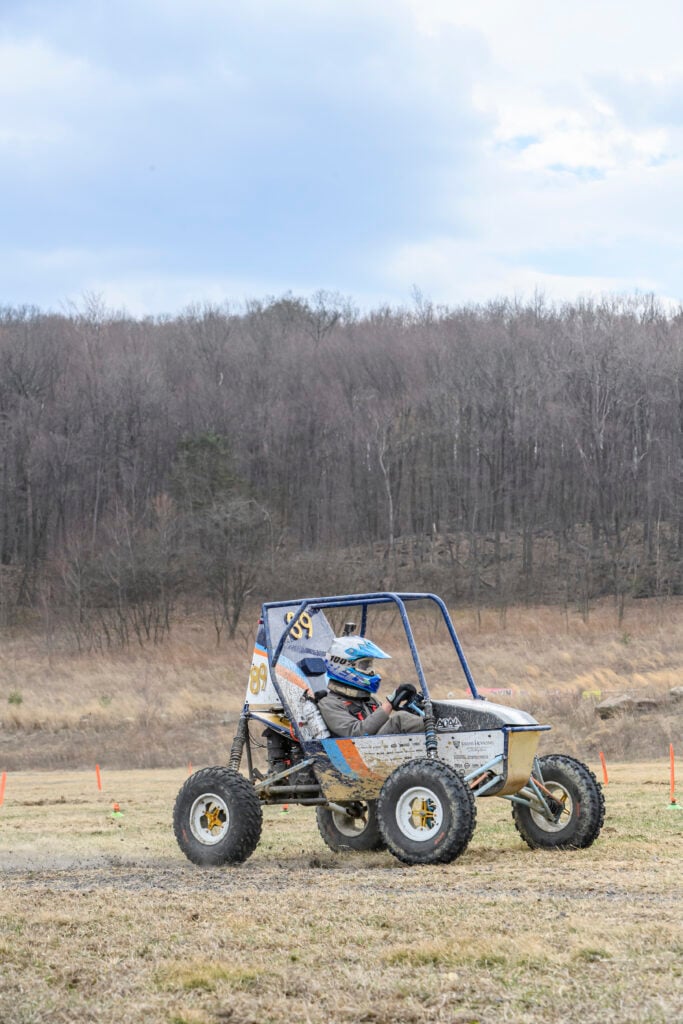Blue Jay Racing achieves a breakthrough third-place finish while developing self-driving technology for their off-road competition vehicle
The Johns Hopkins Blue Jay Racing team recently achieved its best result ever, placing third out of nearly 70 teams at the Baja SAE Arizona competition in early May. While the podium finish marked a historic milestone for the team, the car that performed so well was driven in the traditional way—by humans. However, behind the scenes, a subgroup of team members has been exploring how autonomy might someday allow the vehicle to go it alone.
“We’re really passionate about adding this kind of technology to the vehicle,” said Aaren Wong, a computer science graduate student, director of software engineering and computer systems for Blue Jay Racing, and lead of the Blue Jay Racing autonomy group. The Blue Jay Racing team includes students studying mechanical engineering, electrical and computer engineering, and computer science.
Each year, the Blue Jay Racing team designs and builds a single-seat, off-road, dune buggy-style vehicle that they use to compete against teams from other institutions around the world in a range of categories, including endurance, design presentation, and hill climb.
The idea of incorporating autonomy into the vehicle was born out of a project in the Robot System Programming class taught by Simon Leonard, an assistant research professor of computer science, that provided funding to purchase actuators, devices that are commonly used in autonomous vehicles to convert energy into motion and control the vehicle’s movements.
“Last year in class, we received actuators and learned the software to be able to incorporate computers and microcontrollers into the vehicle. We then retrofitted a vehicle from previous years with radio control (RC) driving functionality, allowing a controller to communicate with a microcontroller that could shift between RC and autonomous modes. We briefly tested this system before things broke down,” explained Wong, who said he thinks that the Blue Jay Racing team is the only Baja team working to incorporate autonomy into their car.
With financial support from the Johns Hopkins Institute for Assured Autonomy, the team’s autonomy subgroup has continued the class project to provide their vehicle with autonomous controls, while other members worked to prepare another vehicle for this year’s competitions. This dual approach reflects the unique challenges of adapting race-optimized vehicles for autonomous operation.
The team’s vehicles use 10-horsepower internal combustion engines rather than standard automotive powertrains, giving drivers full control over vehicle speed and torque.
“The car is extremely optimized for a single-seat, racing dune buggy. The competition [at events] is super high, but the car is not very optimized to be a base for autonomy,” explains Tyler Stanley, Engr ’25 the team’s chief financial officer. “It was cool to watch Aaren [Wong], and his team take a car that was made to be driven by a person and try to make it drivable by computer.”
While several autonomy team members graduated this week, returning members plan to continue advancing the technology in the fall. While current competition rules prohibit autonomous driving, the team aims to refine its system for future applications.
“It can be pretty difficult work because you need a lot of different engineers, a lot of different subsets, and skills. I’m excited to see how the team pushes the work forward in the next year,” says Wong.
Image credit: Will Kirk / Johns Hopkins University.
